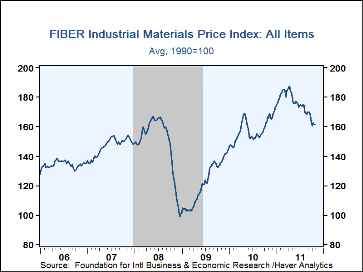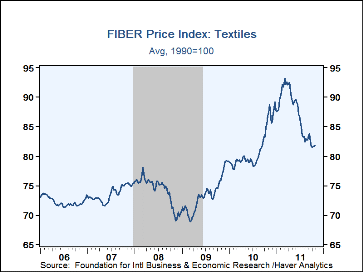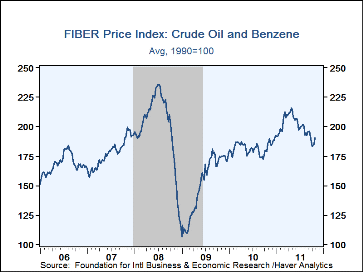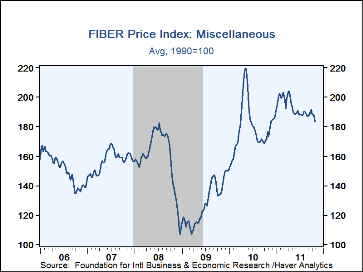 Global| Nov 02 2011
Global| Nov 02 2011FIBER: Industrial Commodity Prices Stage A Broad-based Retreat
by:Tom Moeller
|in:Economy in Brief
Summary
Industrial commodity prices weakened broadly with recent evidence of a lethargic economy. At 161.7, the latest price index from the Foundation for International Business and Economic Research (FIBER), which covers industrial materials [...]
Industrial commodity prices weakened broadly with recent evidence of a
lethargic economy. At 161.7, the latest price index from the Foundation for
International Business and Economic Research (FIBER), which covers industrial
materials prices, was at its lowest in twelve months. Year-to-year, the decline
is a modest 2.9%, but since the April peak prices have fallen 13.6%.
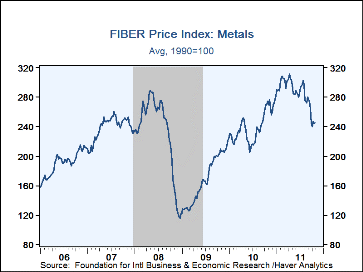
Weakness amongst the FIBER index subgroups has been broad-based. Textiles prices were led lower by cotton which fell by nearly one-quarter y/y and have halved their spring peak. Crude oil & benzene prices also fell with crude oil at $90.74, though recently there has been tentative stabilization. Regardless, they remained down versus the spring, 2011 peak of $113.93. Prices in the miscellaneous group fell with lower lumber and rubber prices. Lumber prices recently have held up but rubber prices continued down. Prices in the metals group continued weak. Prices for copper scrap fell sharply, off by one-quarter from the peak, but recently found a floor. Steel scrap prices have just leveled off at their recovery high. Lead, zinc and aluminum prices remain depressed.
Overall, prices for industrial materials should be characterized as a coincident indicator of the economy. As such, recent weakness paints a picture of lost forward momentum. Glimmers of a rebound are to be found in various prices, but the lack of a broad-based recovery in prices suggests continued moderate economic growth.
Commodity price data can be found in Haver's DAILY, WEEKLY, USECON and CMDTY databases.
| FIBER Industrial Materials Price Index (1990=100) | 10/28/11 | Y/Y % | 2010 | 2009 | 2008 |
|---|---|---|---|---|---|
| All Items | 161.7 | -2.9 | 158 | 121 | 149 |
| Textiles | 81.8 | -5.8 | 81 | 73 | 74 |
| Cotton (cents per pound) | 97.4 | -21.4 | 87.8 | 52.5 | 58.0 |
| Metals | 245.2 | -10.5 | 240 | 168 | 233 |
| Aluminum ($ per metric ton) | 2,180.3 | -6.7 | 2,172 | 1,662 | 2,571 |
| Copper Scrap (cents per pound) | 337.4 | -13.6 | 327 | 197 | 280 |
| Steel Scrap ($ per ton) | 418.3 | 26.2 | 326 | 204 | 350 |
| Crude Oil & Benzene | 190.7 | 2.7 | 182 | 151 | 200 |
| Crude Oil ($ per Barrel) | 90.74 | 8.3 | 79.43 | 61.71 | 99.73 |
| Miscellaneous | 183.8 | 4.3 | 179 | 128 | 159 |
| Natural Rubber (cents per pound) | 228.2 | 9.4 | 182 | 84 | 124 |
| Framing Lumber ($ per 1000 board ft.) | 260 | -1.2 | 282 | 221 | 253 |
FIBER is the Foundation for International Business & Economic Research
Tom Moeller
AuthorMore in Author Profile »Prior to joining Haver Analytics in 2000, Mr. Moeller worked as the Economist at Chancellor Capital Management from 1985 to 1999. There, he developed comprehensive economic forecasts and interpreted economic data for equity and fixed income portfolio managers. Also at Chancellor, Mr. Moeller worked as an equity analyst and was responsible for researching and rating companies in the economically sensitive automobile and housing industries for investment in Chancellor’s equity portfolio. Prior to joining Chancellor, Mr. Moeller was an Economist at Citibank from 1979 to 1984. He also analyzed pricing behavior in the metals industry for the Council on Wage and Price Stability in Washington, D.C. In 1999, Mr. Moeller received the award for most accurate forecast from the Forecasters' Club of New York. From 1990 to 1992 he was President of the New York Association for Business Economists. Mr. Moeller earned an M.B.A. in Finance from Fordham University, where he graduated in 1987. He holds a Bachelor of Arts in Economics from George Washington University.


